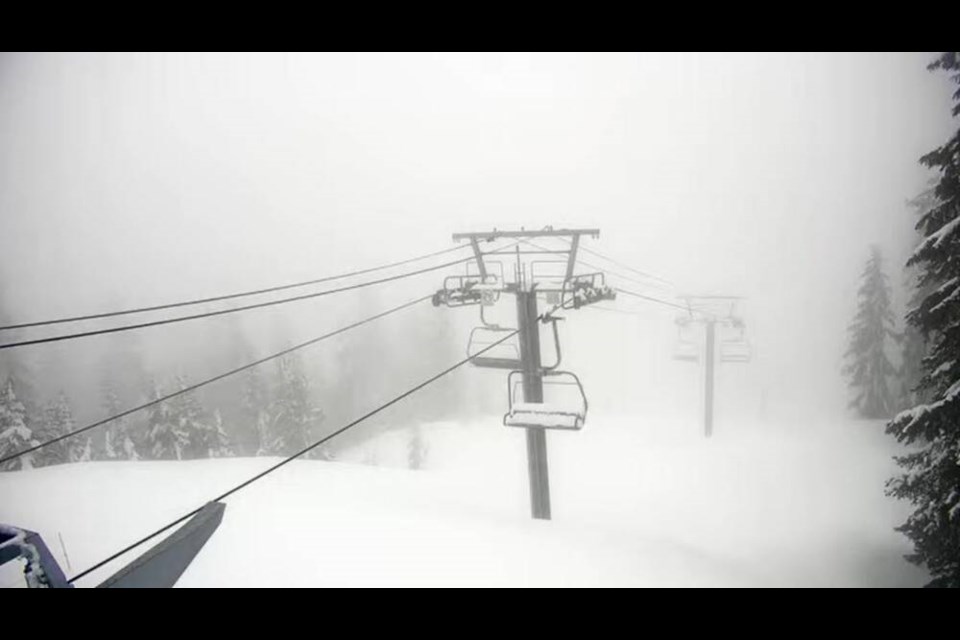Lumps of snow sit on idle chairlifts. Swathes of untracked powder betray an uncommon stillness.
These visions display on ski resort webcams and in the imaginations of avid mountain users, whose desire to hit the slopes extends beyond operational closing dates.
Mt. Seymour ran its lifts for the last time April 9, and Cypress Mountain Resort closed April 16, extending its season to include another weekend. Grouse Mountain is open until Sunday, but closed its Olympic Express Chair last weekend, along with the majority of its piste.
But heavy snow has continued to fall throughout the past week, and all the local resorts continue to boast a deep snow base. This has led to skiers and snowboarders taking to social media, to ask why the hills are closing when conditions are good.
From the resorts' perspective, the decision of when to close is a combination of staffing considerations and a drop-off in the number of mountain users.
“Mt. Seymour sets our closing date before we open for the season and always makes the date known on our website,” explained Simon Whitehead, marketing manager at the resort. This season, the mountain opened Dec. 1, two weeks ahead of schedule, he added.
“One of the main considerations for setting our closing date is to help our seasonal staff, which make up the majority of our employees, plan ahead for other employment,” Whitehead said. “Once we have reached the middle of March, it is a challenge to operate the resort based upon employees leaving.”
The other main consideration is that for many families, activities like baseball and soccer begin in April, which means a significant drop in mountain visits, Whitehead said, so operating the ski area becomes less viable.
“In previous years we have operated Mt. Seymour much later into April with very few season pass holders or lift ticket purchasers visiting the mountain,” he said.
Cypress Mountain usually closes on the same date every year, but extended a weekend this season, said spokesperson Joffrey Koeman. This is the time that most resorts in B.C. close for the season, he added.
Both Seymour and Cypress lease park land from the province, under recreation permits, which has lead to many mountain users wondering if they can access runs by hiking up after the close dates.
Under the permits, Seymour’s ski season is defined as between the dates of Nov. 15 and May 15. For Cypress, it’s between Nov. 1 and May 31. Within those dates, the resorts have the ability to control the activities of all people within their respective “controlled recreation areas” – which includes entry and eviction.
“Visitors to the parks wishing to access the backcountry during the above referenced dates are welcomed and encouraged to use the designated backcountry access corridors to travel around/through the CRA’s and access other areas of the park outside of the CRA,” a Ministry of Environment spokesperson said by email. “Park visitors should not be accessing the CRA for skiing and snowboarding when the resorts are closed.”
Mt. Seymour asks that backcountry users stay on backcountry trails, Whitehead said, “as we have unmarked hazards and machinery on-hill preparing for next winter.”
Cypress did not provide comment on accessing its recreation areas until the end of the permit period.
Grouse pays an annual lease fee to operate its tram and parking lot, which are adjacent to Metro Vancouver park land, but the resort itself is on privately held land.
Mountain resorts 'need to have all seasons represented'
Shutting down operations while there’s snow on the mountains is a bad use of resources, says Chase Wright, who lives in the Mount Pleasant area of Vancouver but commutes to work on the North Shore and to snowboard at Cypress.
“If you’re going to have a mountain like that, you should probably have it open whenever there’s snow, right?” he said.
Eventually, there might be a few bad winter seasons due to climate change, Wright said. “Then do we have local mountains anymore? Or do they shut down?”
“If you want to create a consistent and sustainable mountain culture, you need to have all seasons represented,” he continued, pointing to Whistler’s transition to downhill biking in the warmer months. Grouse continues to lift guests up the mountain throughout the year – hosting activities like ziplining, birds of prey demonstrations and a tree canopy rope course – but bikes aren’t allowed on the tram.
“There’s no one on the North Shore that’s doing gondola cycling in the summer,” Wright said. “They’re not really fully utilizing the mountain to its best potential – especially in those crossover seasons, they should be able to adapt to switching sooner to biking or switching later for skiing.”
Drawing on his travel experiences, Wright referenced mountain cultures in Europe that have developed to accommodate dual seasons. One shining example is the town of Grindelwald, nestled in a valley in Switzerland’s Bernese Alps. The region hosts world-class skiing in the winter, and hiking in the warmer months. Much of the area is interconnected by trains and gondolas.
“You’ve got a completely transit-oriented, year-round gondola supporting the entire region where you can have hotels up there, you can have bars up there,” he said. “They’re not these monster resorts – they’re like a little 50-person hotel. And it’s just the coolest mountain experience.”
Wright said there’s a big fear that we could over-develop, and lose too much of the pristine wilderness on the North Shore, which is a valid concern.
But there’s room to strike a balance, he said.
“If you go up there on a busy day, it’s just a zoo,” Wright said. “There’s not enough outdoor space for everyone going up there.... I think there’s a real desire for people to have more fun outdoor spaces that are respectfully and environmentally developed.”





